Abstract
Odontoblasts are responsible for the formation and maintenance of dentin. They are known to synthesize unique gene products including dentin sialophosphoprotein (DSPP). Another unique genes of the cells remain unclear.
OD314 was isolated from the odontoblasts/pulp cells of rats and partially characterized as an odontoblast-enriched gene (Dey et al., 2001). This study aimed to elucidate the biological function of OD314, relating to odontoblast differentiation and dentinogenesis. After determining the open reading frame (ORF) of OD314 by transient transfection analysis using green fluorescent protein (GFP) expression vector, mRNA in-situ hybridization, immunohistochemistry, reverse transcription-polymerase chain reaction (RT-PCR) and western analysis were performed.
The results were as follows:
1. In in-situ hybridization, OD314 mRNAs were expressed in odontoblasts of developing coronal and root pulp.
2. OD314 was a novel protein encoding 154 amino acids, and the protein was mainly expressed in cytoplasm by transient transfection analysis.
3. Mineralized nodules were associated with multilayer cell nodules in the culture of human dental pulp cells and first detected from day 21 using alizarin-red S staining.
4. In RT-PCR analysis, OD314, osteocalcin (OC) and DSPP strongly expressed throughout 28 days of culture. Whereas, osteonectin (ON) mRNA expression stayed low up to day 14, and then gradually decreased from day 21.
5. Western blots showed an approximately 17 kDa band. OD314 protein was expressed from the start of culture and then increased greatly from day 21.
In conclusion, OD314 is considered as an odontoblast-enriched gene and may play important roles in odontoblast differentiation and dentin mineralization.
Figures and Tables
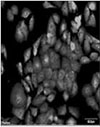 | Figure 1OD314 protein expression in short-ORF transfected HEK 293T cells (× 400). OD314 protein are expressed in the cytoplasm of the HEK 293T cell. |
 | Figure 2The nucleotide sequence of cDNA and deduced amino acid sequence of OD314. Contains 1197 nucleotides in all. The poly a tail is preceded by the polya (A+) signal AATAAA (italics). The start codon ATG is in bold type and begins from nucleotide 423. The stop codon at nucleotide 884 is also in bold denoting the end of the open reading frame (ORF). |
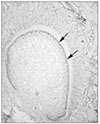 | Figure 3
In-situ hybridization for OD314 in rat mandibular first molar at postnatal day 7. Arrows indicate the OD314 mRNA in the developing odontoblasts. × 100. |
 | Figure 4Expression of mRNA for OD314 in rat mandibular first molar at postnatal day 7. OD314 transcripts are strongly expressed in the developing odontoblasts (arrows). D; dentin, P; pulp, Alv, alveolar bone. × 100. |
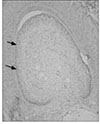 | Figure 5Negative control of in-situ hybridization. No positive signals were found in this section. × 100. |
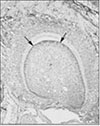 | Figure 6Immunohistochemical localization of OD314 protein in rat mandibular first molar at postnatal day 7. Arrows indicate the OD314 protein in the developing odontoblasts. P, pulp; Alv, alveolar bone. × 100. |
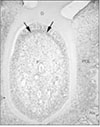 | Figure 7Immunohistochemical localization of OD314 protein in rat mandibular first molar at postnatal day 40. OD314 proteins are strongly expressed in subodontoblasts (arrows). D, dentin; P, pulp; PDL, periodontal ligament; Alv, alveolar bone. × 100. |
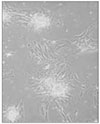 | Figure 9Human dental pulp cells after 21 days of culture. Formation of mineralization nodules in human dental pulp cells in vitro after β-glycerophosphate treatment. × 200. |
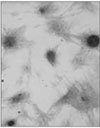 | Figure 10Visualization of mineralization nodules by Alizarin-red S stain after 21 days of culture. × 200. |
 | Figure 11RT-PCR amplification of OD314, DSPP ON, and OC transcripts in the culture of human dental pulp cells. Total RNAs were extracted from cultured cells after 0, 4, 7, 14, 21, and 28 days of culture. GAPDH used as a control. Sizes are indicated at right. DSPP, dentin sialophosphpprotein; ON, osteonectin; OC, osteocalcin; GAPDH, glyceraldehyde 3-phosphate dehydrogenase. |
References
2. Fitzgerald M, Chiego DJ Jr, Heys DR. Autoradiographic analysis of dontoblast replacement following pulp exposure in primate teeth. Arch Oral Biol. 1990. 35:707–715.

3. Shiba H, Uchida Y, Kamihagi K, Sakata M, Fujita T, Nakamura S, Takemoto T, Kato Y, Kurihara H. Transforming growth factor-β1 and basic fibroblast growth factor modulate osteocalcin and osteonectin/SPARC syntheses in vitamin-D-activated pulp cells. J Dent Res. 2001. 80(7):1653–1659.

4. Tziafas D, Kolokuris I. Inductive influences of demineralized dentin and bone matrix on pulp cells: an Approach of secondary dentinogenesis. J Dent Res. 1990. 69(1):75–81.

5. Tziafas D, Papadimitrious S. Role of exogenous TGF-β in induction of reparative dentinogenesis in vivo. Eur J Oral Sci. 1998. 106(1):192–196.

6. Hirst KL, Simmons D, Feng J, Aplin H, Dixon MJ, MacDougall M. Elucidation of sequence and the genomic organization of the human dentin acidic phosphoprotein1( DMP1) gene: exclusion of the locus from a causative role in the pathogenesis of dentinogenesis imperfecta type II. Genomics. 1997. 42:38–45.

7. Narayanan K, Srinivas R, Ramachandran A, Hao J, Quinn B, George A. Differentiation of embryonic mesenchymal cells to odontoblast-like cells by overexpression of dentin matrix protein 1. Proc Natl Acad Sci U S A. 2001. 98(8):4516–4521.

8. Nakashima M, Mizunuma K, Murakami T, Akamine A. Induction of dental pulp stem cell differentiation into odontoblasts by electroporation-mediated gene delivery of growth/differentiation factor 11(Gdf11). Gene Therapy. 2002. 9(12):814–818.

9. Shimo T, Wu C, Billings PC, Piddington R, Rosenbloom J, Pacifici M, Koyama E. Expression, gene regulation, and roles of Fisp 12/CTGF in developing tooth germs. Dev Dyn. 2002. 224(3):267–278.

10. About I, Camps J, Mitsiadis TA, Bottero MJ, Butler W, Franquin JC. Influence of resinous monomers on the differentiation in vitro of human pulp cells into odontoblasts. J Biomed Mater Res. 2002. 63(4):418–423.

11. Murakami S, Muramatsu T, Shimono M. Expression and localization of connexin 43 in rat incisor odontoblasts. Anat Embryol. 2001. 203:367–374.

12. Schmitt R, Ruch JV. In vitro synchronization of embryonic mouse incisor preodontoblast and preameloblast: repercussions on terminal differentiation. Eur J Oral Sci. 2000. 108:311–319.

13. Nakashima K, Zhou X, Kunkel G, Zhang Z, Deng JM, Behringer RR, de Crombrugghe B. The novel zinc finger-containing transcription factor Osterix is required for osteoblast differentiation and bone formation. Cell. 2002. 108(17-29):17–29.

14. Butler WT. Dentin-specific protien. Methods in Enzymology. 1987. 145:290–303.
15. Butler WT. Dentin matrix protein. Eur J Oral Sci. 1998. 106(91):204–210.
16. George A, Sabsay B, Simonian PAL, Veis A. Characterization of a novel dentin matrix acidic phosphoprotein. J Biol Chem. 1993. 268(17):12624–12630.
17. Ritchie HH, Hou H, Veis A, Butler WT. Cloning and sequence determination of rat dentin sialoprotein, a novel dentin protein. J Biol Chem. 1994. 269(5):3698–3702.

18. Ritchie HH, Ritchie DG, Wang LH. Six decades of dentinogenesis research: Historical and prospective views on phosphophoryn and dentin sialiprotein. Eur J Oral Sci. 1998. 106(1):211–220.
20. Dey R, Son HH, Cho MI. Isolation and partial sequencing of potentially odontoblast-specific/enriched rat cDNA clones obtained by suppression subtractive hybridization. Arch Oral Biol. 2001. 46:249–260.

21. About I, Bottero MJ, de Denato P, Camps J, Franquin JC, Mitsiadis TA. Human dentin production in vitro. Exp Cell Res. 2000. 258:33–41.
22. Butler WT, Bhown M, Brunn JC, D'souza RN, Farach-carson MC, Hartha RP, Schrohenloher RE, Seyer JM, Somerman MJ, Foster RA, Tomana M, Djik SV. Isolation, charaterization and immunolocalization of a 53-KDal dentin sialoprotein(DSP). Matrix. 1992. 12:343–351.

23. D'souza RN, Cavender A, Sunavala G, Alvarez J, Ohshima T, Kulkarni AB, Macdougall M. Gene expression patterns of murine dentin matrix protein 1(Dmp1) and dentin sialiphosphoprotein(DSPP) suggest distint developmental functions in vivo. J Bone Miner Res. 1997. 12:2040–2049.
24. MacDougall M, Simmons D, Luan X, Nydegger J, Feng J, Gu TT. Dentin phosphoprotein and dentin sialoprotein are cleavage products expressed from a single transcript coded by a gene on human chromosome 4. J Biol Chem. 1997. 272(2):835–842.

25. Qin C, Cook RG, Orkiszewski RS, Butler WT. Identification and characterization of the carboxyl-terminal region of rat dentin sialoprotein. J Biol Chem. 2001. 276(2):904–909.

26. Buchaills R, Couble ML, Magloire H, Bleicher F. A substractive PCR-based cDNA library from human odontoblast cells: identification of novel gene expressed in tooth forming cells. Matrix Biol. 2000. 19:421–430.
27. Takeda K, Ichijo H, Fujii M, Mochida Y, Saitoh M, Nishitoh H, Sampath TK, Miyazono K. Identification of a novel bone morphogenetic protein-responsive gene that may function as a noncoding RNA. J Biol Chem. 1998. 273(27):17079–17085.

28. Qin C, Brunn JC, Cadenna E, Ridall A, Tsujigiwa H, Nagatsuka H, Nagai N, Butler WT. The Expression of dentin sialophosphoprotein gene in bone. J Dent Res. 2002. 81(6):392–394.

29. Gronthos S, Brahim JL, Fisher LW, Cherman N, Boyde A, DenBesten P, Robey PG, Shi S. Stem cell properties of human dental pulp stem cell. J Dent Res. 2002. 81(8):531–535.

30. Hanks CT, Sun ZL, Fang DN, Edwards CA, Wataha JC, Ritchie HH, Butler WT. Cloned 3T6 cell line from CD-1 mouse fetal molar dental papillae. Connect Tissue Res. 1998. 37(3-4):233–249.

31. Hao J, Narayanan K, Ramachandran A, He G, Almushayt A, Evans C, George A. Odontoblast cells immortalized by telomerase produce mineralized dentin-like tissue both in vitro and in vivo. J Biol Chem. 2002. 227(22):19976–19981.
32. Lundquist P, Ritchie HH, Moore K, Lundgren T, Linde A. Phosphate and calcium uptake by rat odontoblast-like MRPC-1 cell concomitant with mineralization. J Bone Miner Res. 2002. 17(10):1801–1813.

33. Sun ZL, Fang DN, Wu XY, Ritchie HH, Bègue-kirn C, Wataha JC, Hanks CT, Butler WT. Expression of dentin sialoprotein(DSP) and other molecular determinants by a new cell line from dental papillae, MDPC-23. Connect Tissue Res. 1998. 37(3-4):251–261.

34. Thonamann B, Schmalz G. Bovine dental papilladerived cells immortalized with HPV 18 E6/E7. Eur J Oral Sci. 2000. 108:432–441.

35. Thonemann B, Schmalz G. Immortalization of bovine dental papilla cells with simian virus 40 large t antigen. Arch Oral Biol. 2000. 45:857–869.

36. Ueno A, Kitase Y, Moriyama K, Inoue H. MC3T3-E1-conditioned medium-induced mineralization by clonal rat dental pulp cells. Matrix Biol. 2001. 20:347–355.

37. Couble ML, Farges JC, Bleicher F, Perrt-Mabillon B, Boudeulle M, Maloire H. Odontoblast differentiation of human dental pulp cell in explant culture. Calcif Tissue Int. 2000. 66:129–138.

38. Gronthos S, Mankani M, Brahim J, Robey PG, Shi S. Postnatal human dental pulp stem cells (DPSCs) in vitro and in vivo. Proc Natl Acad Sci U S A. 2000. 97(25):13625–13630.
39. Guo L, Berry JE, Somerman MJ, Davidson RM. A novel method to odontoblast from rat incisor. Calcif Tissue Int. 2000. 66:212–216.




 PDF
PDF ePub
ePub Citation
Citation Print
Print





 XML Download
XML Download